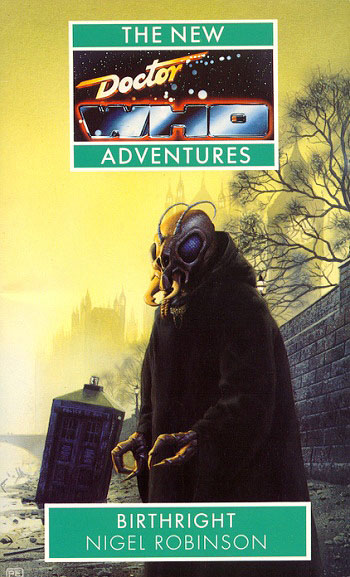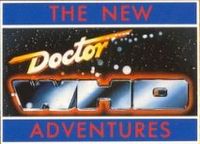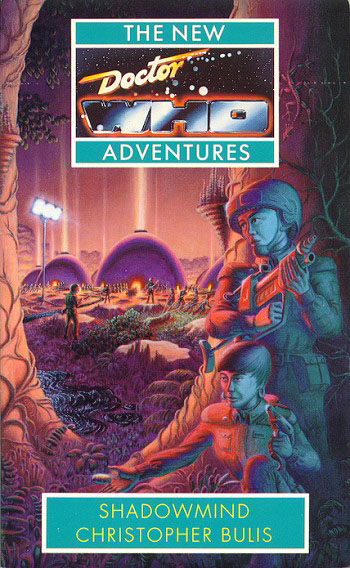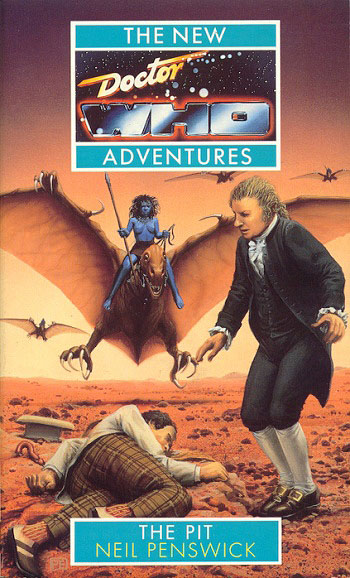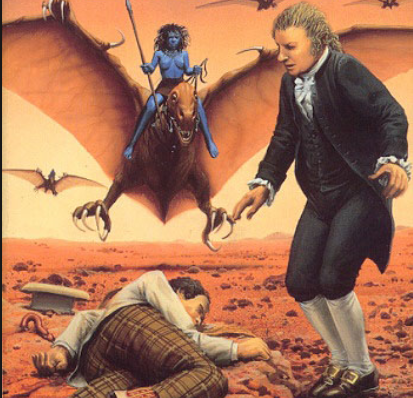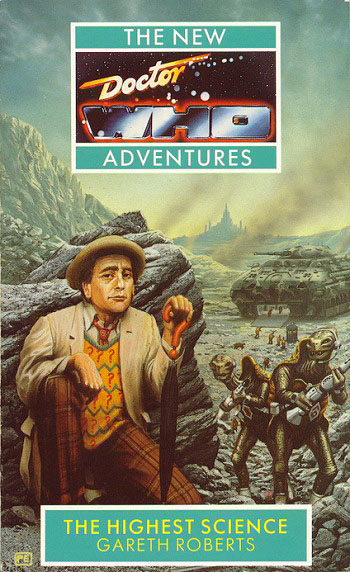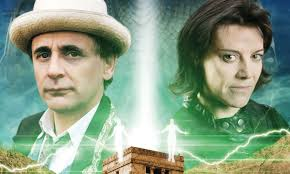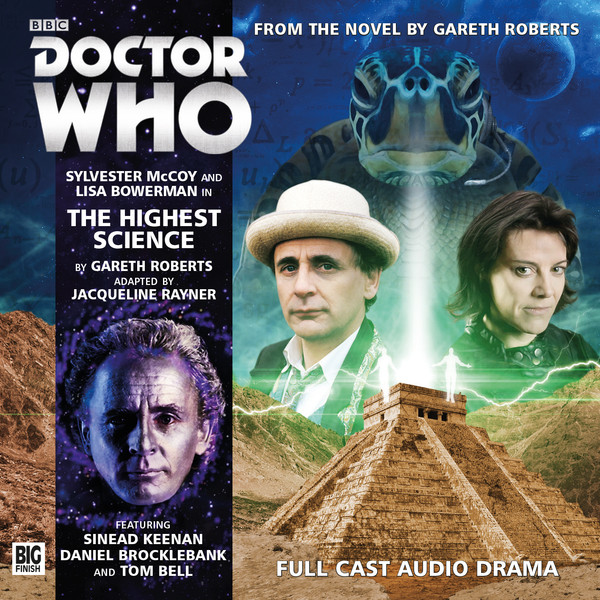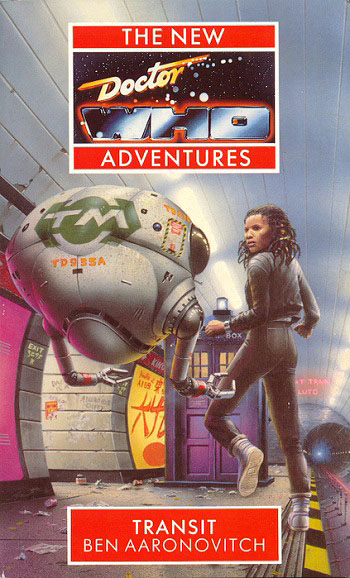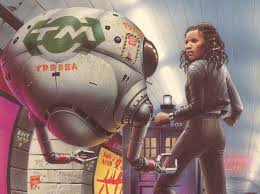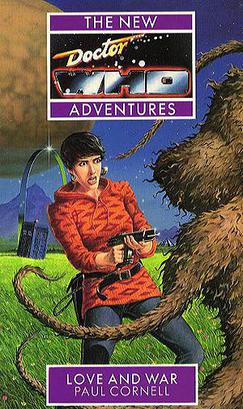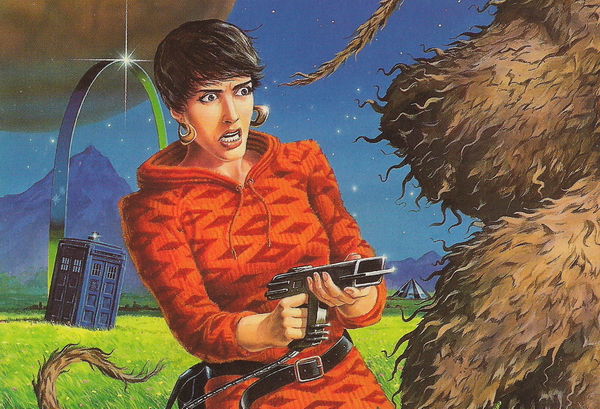We’re back, with another Doctor Who novel review! This week, we continue the Virgin New Adventures (VNA) series with the eighth entry, Nightshade, by writer and actor Mark Gatiss. Published in August 1992, this book is our first standalone novel after the Timewyrm tetralogy and the Cat’s Cradle trilogy. Let’s get started!
Spoilers ahead for anyone who has not read this novel!
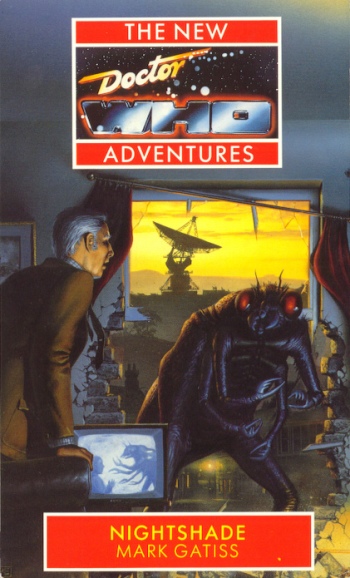
Eight old men on Gallifrey visit the cloisters. One slips away and steals a TARDIS; the leader of the group discovers it and disapproves.
December 22-23, 1968: WW1 veteran Jack Prudhoe dodges an argument with his wife Win and goes to the local pub. He reminisces about meeting her in 1916; then he sees what he believes, impossibly, to be the 1916 version of Win outside the window. He follows outside onto the moor in the rain, and into a shallow cave, where he is killed by something large and dark.
Aging former actor Edmund Trevithick once played the adventurous Professor Nightshade on television. Now the series is being replayed on the new BBC2, and the BBC wants to interview him at Dalesview Residential Home, for old times’ sake. As he goes to bed, his nurse, Jill Mason, is frightened by something monstrous outside. Later, something smashes Trevithick’s window and menaces him.
Lovers Holly Kidd and Vijay Degun work as technicians at Hawthorne and Cooper Space Tracking Station, a radio telescope near the village. Shortly after 5 AM on the 23rd, the telescope–trained on Bellatrix in the Orion quadrant–picks up alarming readings at the same time as a security breach alarm. Vijay finds the security guard missing and a hole in the fence, and then is chased back to the facility by something large and fearsome.
In the village, Betty Yeadon, the second wife of pub owner Lawrence Yeadon, has a mysterious chronic illness. Her situation–and her husband’s unwarranted cheerfulness about it–is a hot topic of gossip.
A mile from the station, along the road to nearby St. Hilda’s Monastery, homeless man Billy Coote witnesses the early morning arrival of the TARDIS.
Ace reflects on the Doctor’s recent spell of brooding. She discovers him in his nightclothes; unexpectedly he takes her on a search through the TARDIS, ending at a long-disused, stone-decorated tertiary console room. He relocates it to the main entrance. Ace discovers an old Coal Hill jacket, which once belonged to Susan, prompting the Doctor to snap at her before abruptly switching to a good humor. He dresses, then leads her outside.
Betty Yeadon wakes up from a nightmare about her dead brother, Alfie, who died in a WW2 ship sinking. She takes medication, and gets her stepson Robin out for the morning, before giving in to her fear in the pub.
Robin meets the Doctor and Ace, and refers them to a cafe for breakfast. The Doctor ruminates on retiring to Gallifrey, then leaves for the monastery to think, promising to meet at the pub at 8:30 pm. Ace sees Vijay come in and try to call Cambridge, but all lines are down.
Betty goes to take a bath, but passes out when she sees what looks like her dead and rotted brother rise from the tub. At the same time, the tracking station detects more activity.
Ace discusses the telescope and current events with Mrs. Crithin at the cafe; she then goes outside and spots Vijay’s car. Investigating it, she gets inside, but is forced to stay put and hide when he returns and drives away.
The Doctor walks to the monastery. In the greenhouse he meets the exceedingly jolly abbot Mervyn Winstanley, and asks to spend time at the monastery.
Betty’s vision continues, terrifying her and causing her to scream until she passes out. Lawrence sends Robin for a doctor, as the phones are still out.
Trevithick and Jill meet a constable, George Lowcock, who expresses little expectation for the investigation. Robin then arrives, having been unable to find local physician Dr. Shearsmith, and gets Jill to go check on his mother. Trevithick accompanies them.
Ace, driven by Vijay onto the station grounds, finds herself trapped inside the fence. When she finds the hole in the fence, she discovers the decaying body of the missing guard. She runs into the station, startling Hawthorne and Cooper.
At the pub, Trevithick talks with Lowcock about the disappearance of Prudhoe and Shearsmith. They are interrupted by Betty’s renewed screaming.
The Doctor reads a history of the area which implies that locals have been subject to terrible fears for centuries.
In 1644, Cromwell routes an army led by Prince Rupert near Crook Marsham. Survivors led by Sir Harry Crooke hide in the village’s ruined Norman castle, hunted by Cromwell’s man Philip Jackson. Cooke sees apparitions of his dead daughters, which turn into a fiery creature that consumes him; his men flee in terror, and are captured by Jackson. Jackson investigates the castle, but sees strange energies, and flees in terror just before it explodes and burns out of existence.
Finishing the book, the Doctor inquires about the castle site; the abbot tells him that the telescope was built on the spot.
Hawthorne, a diehard racist, muses on the path that brought him here (including a bit of childhood trauma regarding the Tar Baby in the Brer Rabbit stories, which he associates with his perceived racial inferiors). He is interrupted by the arrival of the terrified and manic Ace.
Intent on going through with his plan to retire, the Doctor returns to the pub to meet Ace, who isn’t there; but on mention of his name, Trevithick and Lowcock press him into helping Betty, who is now sedated by Jill. He gets her to sleep peacefully. In the pub, he compares notes with Trevithick regarding the phone outage and the disappearances, but still doesn’t want to get involved. He learns that Ace was interested in the telescope, and leaves to find her; Robin sneaks out to follow him.
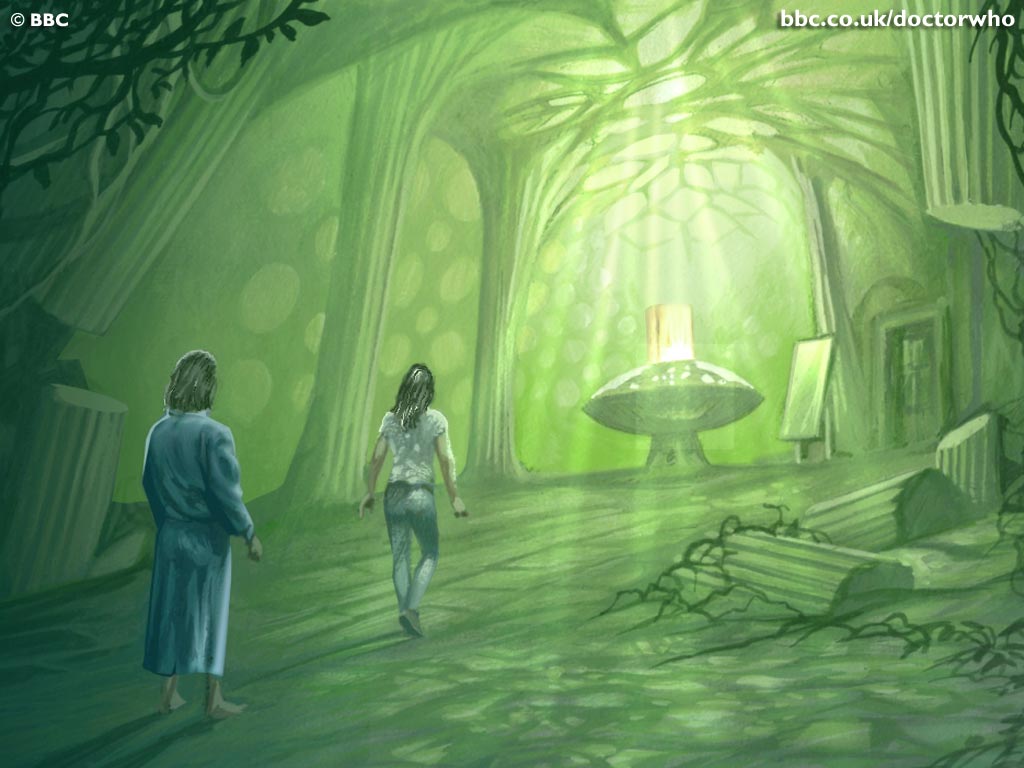
Hawthorne and Cooper interrogate Ace, who reports the dead guard. They are interrupted when the facility gets another data burst, and Hawthorne sends Ace to get Vijay and Holly, who are in bed together. Vijay responds, but lets Holly sleep.
Betty awakens to another vision of her brother.
Robin finds the Doctor to tell him about Ace, but before he can, they find a traumatized Win Prudhoe on the moor. She wanders away, and they find Jack’s rapidly-decomposing body.
Trevithick meets the monster again as he walks home, recognizing it as an insect creature from the nightshade serials. It chases him, and even gives him a small injury, before Lawrence Yeadon’s car runs it off. Lawrence says he and Lowcock couldn’t get out of the village to go for help.
The Doctor and Robin break into the satellite facility and meet everyone but Holly. He quickly ingratiated himself to Cooper asa scientist and identifies the double-star nova that is causing the electronic chatter, and offers to help. He also reports the body of Jack, corroborating Ace’s story about the guard.
Holly dreams of her former lover, James, who died six years ago; she then awakens to an apparition of him in her bedroom.
Billy Coote is sleeping at the monastery, and musing about the headaches that started a few months ago, and about the erratic second sight he has had all his life. A strange wind begins to moan around him; down the hall, the abbot feels it too. At the station, Vijay interrupts Holly’s visitation before it can devour her; he only sees it as a vaguely humanlike cloud.
Ace and Robin sleep in the station breakroom; they are beginning to develop feelings for each other, and nearly kiss in the morning before being interrupted by the Doctor.
Journalist Tim Medway comes to town to interview Trevithick. Trevithick, meanwhile, has stayed overnight in the pub with Lowcock and Yeadon, who are shaken by their encounter with the monster last night. In the morning, They compare notes, and suddenly Yeadon hurries upstairs to check on Betty. He finds her dead and decayed in bed, with the room mangled and the window torn out. Yeadon is hysterical; Lowcock sets Trevithick to watch him, then heads to his police station. Edmund decides to take Yeadon to Dalesview and leave him with another resident while Edmund recovers something useful–his old service revolver.
The Doctor fails to repair the station radio, then interrogates Vijay and Holly about the apparition. Cooper gives him a walkie-talkie, and he takes Ace to the monastery; Robin returns home. As they go, Ace realizes she is beginning to resent the way the Doctor treats her, and to long for human contact–like Robin. Meant, Medway nears town, and finds that all radio stations turn to static a mile out. He encounters a crashed bus with a dead driver; the occupants are Jill and most of the Daleview residents, who were en route to visit various families for Christmas. Jill tells him of a sickly feeling that overcame everyone as they neared the edge of town, terminating in the fatal crash. He denies feeling anything, and helps them all to the nearby monastery. The Doctor and Ace arrive first, and begin researching more local history with the abbot, though not without some small tension between themselves. Ace finds record of an archaeological dig, Paleolithic period, at the station site, which was abandoned under mysterious circumstances.
Medway goes to the police station and meets Lowcock, reporting the accident. Lowcock sends an officer to deal with it, then takes Medway to meet Trevithick.
The Doctor finished his research and gets a call from Cooper, asking him to return–new signals are building up. Ace asks to stay behind–secretly waiting for Robin–and though neither of them admit it, both are preparing for her to leave the Doctor. Leaving the monastery, the Doctor meets Jill and her charges, and learns of the accident.
Robin returns to the pub, thinking about Ace. He learns of his mother’s death, and Yeadon blames him for leaving, and punches him, then apologizes. He views the minimal remains, then admits to finding Jack in the same condition, then leaves. Lowcock and Medway arrive at the same time, and Trevithick reports Robin’s story about Jack; Lowcock tells Trevithick about Jill’s accident. Lowcock relocates Yeadon to a b&b, and Trevithick tells Medway what’s been going on.
The Doctor, Cooper, Vijay and Holly confer. The signals are building steadily, but they aren’t coming from the nova. The Doctor discusses the history of similar, horrific incidents. Hawthorne doesn’t believe it, and nearly starts a fight with Vijay before storming off. Suddenly the signal goes wild again.
Musing about the Doctor and waiting for Robin, Ace briefly joins Jill and the seniors in the monastery great hall, but gets uncomfortable and steps out. Jill gets the residents singing to calm them, but then sees an apparition of one resident’s long-dead husband. It is joined by many other ghostly figures. When the phantoms touch their respective victims, the seniors are consumed in a burst of light and corruption. Jill flees the hall. Ace meets her and sees the conflagration; a moment later, Robin arrives and Ace saves him from death. The creature chases Robin and Ace upstairs, but is distracted by the abbot on an upper floor.
Hawthorne broods angrily in his room.
Medway takes Trevithick to the telescope station, and Trevithick finishes his story en route. They arrive into the chaos of the control room, just as the fence breach alarm sounds again; Cooper goes to investigate. The Doctor realizes something is happening at the monastery.
A Tar Baby apparition takes Hawthorne.
An apparition in the form of a mockery of Jesus kills the abbot.
With the signal surge over, the Doctor leaves for the monastery to check on Ace. The power goes out. Trevithick confers with Holly while Vijay and Medway search for candles; they find Hawthorne’s remains, and Medway flees in terror in his car.
Ace and Robin commiserate while hiding, and kiss.
The Doctor arrives as the creatures fade from the monastery, and meets Jill running out, hysterical; she updates him, and he sends her to gather everyone safely in one place. He goes in to find Ace.
Trevithick confers with Vijay, and realizes the apparitions are all from the victims’ pasts. Vijay’s relationship with Holly is strained by her experience. As the power slowly returns, Holly finds the regular nova signal, plus a fainter but regular pulse in the background.
Medway gets sick as he tries to leave town, but the fatal incident happens when he nearly runs over Jill and wrecks, his car exploding.
Robin and Ace, in the tower now, see the explosion, as do the group at the station. They stay put and discuss the Doctor and Ace’s life, and kiss again. They see Billy Coote approaching from further into the tower, and he appears possessed. At the station, the window explodes; half a dozen of Trevithick’s Nightshade monsters are approaching. The trip flees further inside as the creatures invade, and are forced to split up Trevithick finds an elevator and battles a creature to get inside, then goes up. The creature clings to the bottom of the lift, then breaks through the floor; Trevithick shoots it, to no avail. He rigs a fire extinguisher to the creature, forces it back down onto the cable, sets the elevator going up, then shoots the extinguisher, setting the creature ablaze.
The Doctor arrives at the monastery just as sunrise arrives, and finds nearly everyone dead. He sees an apparition…of Susan, his granddaughter.
Ace and Robin climb to the roof to escape from Billy. Meanwhile the Doctor realizes Susan isn’t real, and rejects the apparition, which turns into the burning cloud creature. He runs for the stairs up to the tower.
Yeadon is assaulted by an apparition of Betty in the apartment over the pub.
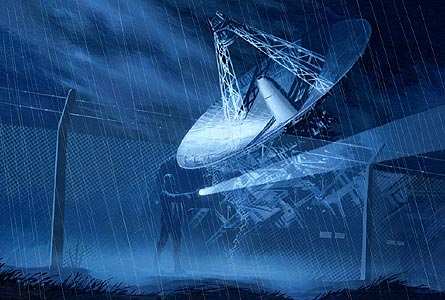
Vijay and Holly awaken and go outside, and find Cooper beneath a vehicle, injured but alive. The fence has been blown down—or rather, toppled by ground subsidence—and a “fairy ring” around the station is flattened and scorched. They discover that the Paleolithic quarry beneath the grounds has been opened.
Lowcock tries to gather the residents into the church as recommended, but finds that most of the village—including Win Prudhoe—have been consumed. Only about sixty survivors join him and Jill in the church.
The Doctor gains the tower; his encounter with the Susan apparition has forced him to face the feelings that led him to want to retire, and he isn’t prepared for it. In the tower, he finds Ace’s earring from Segonax on the floor, and then encounters the possessed Billy Coote, whose eyes have gone from normal, to all black, to transparent. The Doctor tries to confront him, realizing he is mentally linked to something. Ace and Robin hear him, but remain on the roof.
Trevithick awakens in the level 18 corridor, and takes the elevator back down, aiming for the control room on Level 8, which is the ground level (the lower levels are underground). The elevator doesn’t stop, and through the hole in the floor, he sees a web of light. He manages to escape on level 5. Vijay, Holly, and Cooper return to the control room to search for Trevithick, but get distracted by the energy readings, which now show a regular pattern. Cooper realizes it’s coming from underground.
As the Doctor confronts the creature in Billy, Ace returns to the room to get climbing rope from her rucksack for Robin. The creature says it is ancient and doesn’t know what it is or where it came from, but it is hungry for life energy. Ace sets a rope, and Robin makes it to the ground. The creature moves to consume the Doctor, and Ace rolls two globes of Nitro-9-A at it. She descends the rope with the Doctor following, She makes it down safely, but the explosion in the tower causes the Doctor to fall.
Trevithick makes it up to Level 8, but passes out.
The Doctor is alive, but his shoulder is dislocated; Ace and Robin are forced to reset it. He then tells them that the creature—which he labels the Sentience—is ancient, with the Earth possibly having formed around it, and it feeds on energy. Ace’s explosion saved them for now, but made the Sentience stronger. They head for the telescope.
As it grows, the Sentience destroys the Monastery, then begins to tear apart the village, before moving in on the crowd in the church. It finds root in the reactions of an old war veteran, then in Lowcock.
Vijay locates Trevithick and gets him back to the control room just as the Doctor, Ace, and Robin arrive; the group compares notes as the Sentience spreads over the moor and the village. The Doctor concludes that it is emotion, memory, and belief which are feeding the creature, summoning it, causing it to grow. He plans an expedition below ground via the quarry, and will take Trevithick, Vijay, and Holly with him, leaving Cooper to monitor via the equipment; but he forces Ace to stay behind, with Robin to look after her, telling her she is too important to lose. Robin talks with her, and finally asks her to stay behind with him when the Doctor inevitably leaves.
The Sentience confronts the Doctor’s group underground; the Doctor warns them to clear their minds. Holly is unable to do so, and it gets a foothold in her memories, then manifests as her dead fiancé again. This time, she gives in and runs to it, but Vijay knocks her out in an attempt to save her; but unknown to him, the sleeping mind is more vulnerable, and the creature quickly devours her. The Doctor, Trevithick, and Vijay flee the cavern, but encounter more of the nIghtshade creatures. Trevithick realizes they can only exist because his memories give them form; and he chooses to sacrifice himself by attacking them, allowing the Doctor and Vijay to make it back to the telescope station. Trevithick dies still fighting.
The Sentience’s apparitions begin to break into the church despite Lowcock’s efforts at coordinating a defense, though he begins to realize what is feeding them. He finds a trapdoor into the crypt below, and gets everyone inside. At the station, the Doctor admits his failure, and tells Cooper, Ace and Vijay about his vision of Susan. Ace tries to summon the creature in the form of her mother, to determine their chance of success, and to illustrate her belief in the Doctor, who doesn’t believe in himself at the moment. It materializes, but she denies its reality, and without belief from her it is forced to retreat. She then challenges the Doctor to face his past as she faced hers.
The Sentience now has enough strength to fully free itself from its prison in the earth. The Doctor summons it back to him on the strength of his memories of Susan, and it takes her form again. He forces it to confront its hunger, and then locks it onto the feed from the nova coming through the telescope. Finally strong enough to depart, it leaves Earth along the signal, and heads for the star, a practically unlimited source of energy.
With the crisis over, Ace does something difficult: She tells the Doctor she intends to stay behind. He accepts it, and asks her for one last favor: A final trip in the TARDIS, as an experiment. As they board, the Doctor surmises that the nova is 324 light-years away—thus, it happened 324 years ago—and the creature is moving back in time…
The Doctor lands in Crook Marsham in 1644, where Jackson’s and Rupert’s soldiers are being alternately terrified and killed in the castle. The Doctor and Ace deduce that the creature is arriving here from the future before homing in on the nova—and true to expectations, they witness the destruction in fire of the castle as the creature arrives. It was the modern creature, not the historic, that destroyed the castle, before leaving Earth completely. The Doctor and Ace follow it to the nova, then forward in time to the nova’s eventual consumption, then across space to a supernova in Andromeda..and forward again, in time to witness the conversion of the supernova into a black hole. The Sentience, at last, is consumed by the black hole.
The Doctor prepares to take Ace back…but when she steps out of the TARDIS, she finds herself on an alien beach. When she steps back inside, the TARDIS dematerializes…and the Doctor is nowhere to be seen.
Robin waits five months for Ace, but she does not return. Eventually he moves on, to York and beyond, keeping in touch with Cooper, Vijay, and Jill as they pick up the pieces. The telescope station is closed and later dismantled, and life in the village—such as remains—goes on.
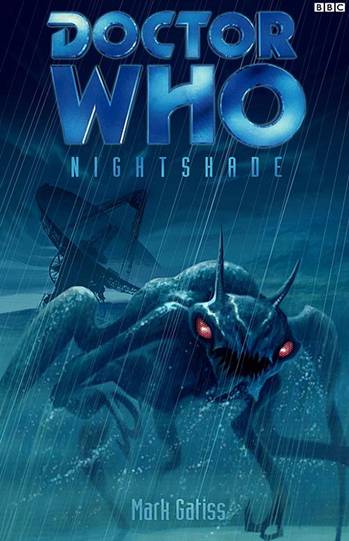
A long run of standalone novels begins with a bang here; the series definitely benefits from being freed from the constraints of a story arc. (Not that Cat’s Cradle was much of an arc, but I digress…). This story finds the Doctor contemplating retirement, even considering a return to Gallifrey. Throughout the novel, he struggles to avoid getting involved with events as he usually does, but ultimately can’t resist; but in the end it is Ace who forces him to confront his past and his future and reconsider his decision. Meanwhile, Ace is facing her own, parallel moment of decision; she falls for a local young man, Robin Yeadon, and decides to stay behind on Earth as so many companions have done before. The Doctor verbally agrees, but ultimately he spirits her away again; the book leaves it unresolved as to whether he did it intentionally, or whether it’s the vagaries of TARDIS travel that prevent her return to Earth. Either way, it seems she will have at least one more adventure with the Doctor, if against her will.
It’s a time of prospective change in many ways; looking slightly ahead, there will be another companion added to the TARDIS in the next book, though that’s not obvious as yet; Ace and the Doctor have their decisions to make; and we get a new TARDIS console room. The tertiary console room is cavernous, made of stone, and long disused; but the Doctor switches it with the primary console room, as the Fourth Doctor once did to the secondary.
There’s a lot of looking back here, as well as looking ahead. We open with a prologue that shows us a view of the First Doctor leaving Gallifrey (though it’s not named as such; the context makes it clear), a view which differs sharply from the one eventually seen in Lungbarrow, or the one seen in The Name of the Doctor. The Doctor’s memories of Susan figure prominently in this story, as do Ace’s memories of her mother; in fact, the concept of memory and its power is the central conceit of the book. Nowhere is this more strongly portrayed than in the character of Edmund Trevithick, an aging actor who once, on television, portrayed the Professor Nightshade from whom the title is drawn. Nightshade is a sort of Doctor Who counterpart, which is also reported to have been based in part on the character of Bernard Quatermass from the classic Quatermass serials (which I hope to see someday; I’ve heard of them for years). Some of Professor Nightshade’s enemies are adopted as forms by the villain in this book, the disembodied Sentience; and Trevithick, while at first enjoying reliving his past, eventually has to literally confront it in the form of the monsters. I like Trevithick; he’s a sparky old man, and still quick of mind, reminiscent of many one-off acquaintances of the Doctor on television. Although the book doesn’t state as much, I can’t help wondering if he is not partly based on Peter Cushing’s “Dr. Who” from the 1960s films; the cover art is a pretty striking resemblance. This is the kind of tribute to the past that I don’t mind at all.
This is a particularly death-filled story, though for once not everyone dies. Perhaps sixty-five of the residents of the village of Crook Marsham survive, but that’s out of a population of perhaps a few hundred. Unlike some Doctor Who stories, this book makes no effort to gloss over it; you feel each and every death that is enumerated (though many are just mentioned en masse). As much as the Doctor complains about getting involved, it would have been a potentially world-wide tragedy if he hadn’t.
There’s a great feeling of nostalgia to be had in this story, which is undoubtedly what Mark Gatiss intended, but it’s a very melancholy nostalgia. While in the end, the Doctor and Ace don’t actually end their travels, there’s a strong feeling of something ending. It’s not a bad thing; for several novels, the series has lingered in the shadow of the final classic season, but eventually it has to grow. Still, the result is a story that is more emotional than its events merit; you’ll be sad, but you’ll enjoy every minute of it. It’s the first book in the New Adventures that I couldn’t put down.
Most of the references in this story are to future VNAs, so I’ll try to mention them without much in the way of spoilers. The Doctor’s departure from Gallifrey, and Susan’s true relation to him, will be addressed again in Lungbarrow, and Susan herself will appear again in An Earthly Child, as well as other locations. Happy Endings will bring back the character of Robin Yeadon, and elaborate on his relationship with Ace, which is not at all what might be expected. Love and War will elaborate on the Doctor’s relationship with Ace after the events of this story. The Doctor’s shoulder injury is noted again in Set Piece. Some television episodes do get a mention, mostly in connection with Susan, such as An Unearthly Child, The Dalek Invasion of Earth, The Reign of Terror, and The Five Doctors; Ace mentions the events of Remembrance of the Daleks. The Doctor also makes very minor reference to several other episodes. The Timewyrm tetralogy gets a mention by Ace.
Overall: My favorite in the series so far. Easily an 8/10 or higher. If you are intimidated by the Timewyrm and Cat’s Cradle novels, you can skip them and begin here.
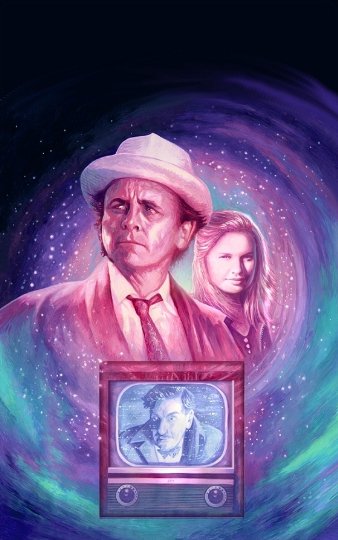
Next time: Love and War, by Paul Cornell! See you there.
Although most of the Virgin New Adventures are now out of print, and therefore are difficult to locate with reliability, this novel (among several others) was adapted to audio drama format by Big Finish Productions, and may be purchased at the link below.
Nightshade (audio)
Previous
Next









